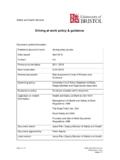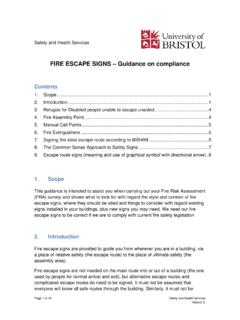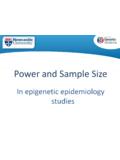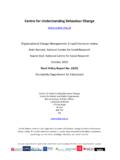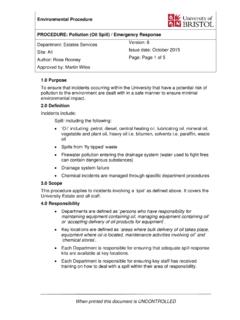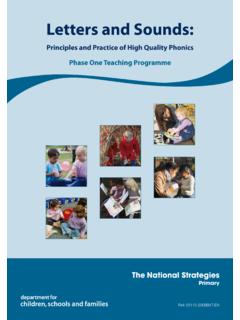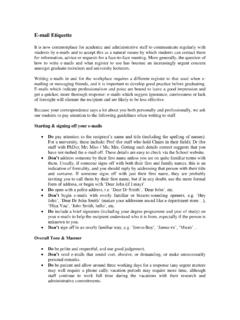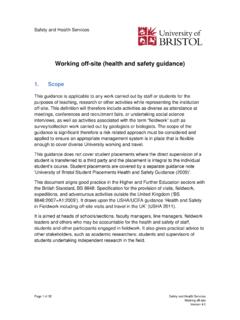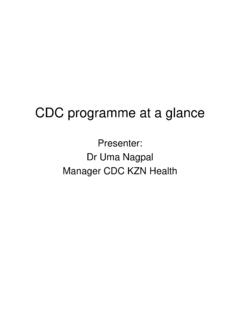Transcription of Learning Disabilities Mortality Review (LeDeR) Programme ...
1 Learning Disabilities Mortality Review (LeDeR) Issue 2, September2018. Programme Learning into Action Bulletin Infection (Sepsis). Four key areas being worked on nationwide There is a lot of clinical work going on na- portant information about the health and tionally to raise the profile of sepsis. care needs of a patient with Learning disa- In July, the NHS England sepsis pro- bilities. gramme helped to run a national work- shop for health and social care profession- 2. To support health and care profession- als. als to spot the signs of acute deteriora- The Learning disability focus was on the tion, including sepsis, in people with better prevention, detection and treat- ment of sepsis.
2 Learning Disabilities . Nicola Spencer, NHS England's pro- gramme delivery manager at Clinical Poli- 3. To support carers to spot the signs of cy Unit based at Quarry House in Leeds, acute deterioration, including sepsis, in has explained there are now four priority people with Learning Disabilities . areas for NHS England, which all came out Current examples of this, include: of that workshop. Restore 2 tool in Hampshire: A patient/. The key areas are: carer facing safety netting tool containing 1. To improve the sharing of important visual representation. information, including electronically, Home Care Company - a framework of about people with Learning Disabilities soft signs which helps the carer to identify between health and care professionals signs that a patient with Learning disabili- across settings.
3 Ties may be deteriorating and provides Current examples of this type of work, advice on when to contact a nurse/GP. includes: Purple folder scheme - used by care homes for people with Learning disabili- 4. To facilitate the promotion and sharing ties. It contains important information of best practice. about the individual to be used when they are admitted to hospital. Further work is now underway to map Red bag scheme or snatch bag' - to be exiting work going on across these areas used in supported living. The bags contain and to establish where there are gaps. An key paperwork, medication and are sent action plan will then be formed with leads with the patient to hospital.
4 Identified from across the system. Hospital passport scheme - captures im- John Trevains , head of Mental Health and Learning Disability Nursing at NHS England The premature Mortality Programme has highlighted why sepsis is such an important issue for people with a Learning disability and earlier this year we held a national workshop to share some of the great things happening on sepsis across the country. This includes how we get better at recognising when someone's health is getting worse and developing easy read information for people with a Learning disability and their families and carers.
5 Latest sepsis data from LeDeR Programme In 2017, 11 per cent of notified deaths to the LeDeR Programme cited sepsis as a cause, or contributory cause, of death. Between January - June 2018, nine per cent of notified deaths to the LeDeR pro- gramme cited sepsis as a cause, or contributory cause, of death. Work being carried out locally to reduce sepsis deaths Here are some examples from around the country of best practice actions to reduce deaths from sepsis: West of England The number of deaths from sepsis has dramatically fallen in the West of England since the area introduced NEWS (National Early Warning System) outside of a hospi- tal setting.
6 Across the region, it is now being used as a common language in primary care, out-of- hours services, mental health services, as well as hospital, acute hospital trusts and the region's ambulance trust. Clinically introducing NEWS across the whole healthcare system has reduced the number of deaths from sepsis. (Click on video below to watch how it was rolled out). Nationally, the SOS (Suspicion of Sepsis) dashboard shows that Mortality from the SOS is lowest in the West of England, compared to the rest of the country, and that reduction in deaths has been directly attributed to the use of NEWS across the entire healthcare system.
7 For further information, email: Toby's life was saved after a GP taught his parents about NEWS. The Royal College of Physicians (RCP). currently recommends that sepsis should be considered in any patient with a NEWS2 score of five, or more. In hospital, Toby was diagnosed with sepsis, secondary to pneumonia. His aunt is Alison Tavar , who is the GP. Clinical Lead at the West of England Aca- demic Health Science Network. Dr Tavar also works as a GP based in Bristol and luckily for Toby and his par- ents - happens to have a special interest in NEWS to improve the detection and This is Toby.
8 He's 18 and has Worster- management of deteriorating patients Drought Syndrome, a rare form of cere- and sepsis. bral palsy. She successfully empowered Toby's par- Toby survived a sepsis infection after his ents to spot the signs themselves so aunt taught his parents how to monitor they could access urgent hospital treat- NEWS (National Early Warning System). ment for Toby - who was 16 at the time. Toby often gets severe chest infections She armed them with enough infor- but struggles to communicate how he's mation by teaching them how NEWS. feeling because of his speech complica- works, which helped them take the ur- tions.
9 Gent decision to rush him to hospital. When he fell ill with another chest infec- Toby was treated for sepsis and was sent tion, his parents were able to quickly home from hospital a week later. The take him to hospital having correctly outcome could have been very different identified that he had a NEWS score of if his mum had not used NEWS. six. Hertfordshire At East & North Herts NHS Trust, the sepsis nurses investigate the circumstances of all patients who either were not screened for sepsis, or did not received treatment, within one hour of being recognised as septic. Following several deaths of people with Learning Disabilities , the sepsis team now takes a proactive approach to caring for people with Learning Disabilities , regardless of their reason for admission, in recognition that they are at high risk of infection and therefore sepsis.
10 In a trust with approximately 700 beds, they typically have between four to six in- patients with Learning Disabilities at any one time. The team monitors the patient's vital signs remotely via the electronic observations system, ready to intervene at the earliest sign of deterioration. The team also works closely with ward staff, Learning Disabilities liaison nurses, any carers involved and the safeguarding lead nurse to establish the patient's baseline and communicate any concerns, if assumptions appear to have been made, to guard against diagnostic overshadowing. The sepsis team has also been working with the Health Liaison Team at Herts County Council for the last year, teaching community Learning disability staff about sepsis prevention and recognition and developing sepsis resources.
